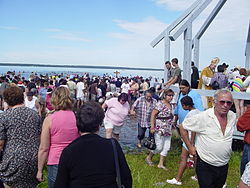Lac Ste Anne
| Lac Ste. Anne | |
|---|---|

Pilgrims on Lac Ste. Anne
|
|
| Location | Lac Ste. Anne County, Alberta |
| Coordinates | 53°42′30″N 114°27′37″W / 53.70833°N 114.46028°WCoordinates: 53°42′30″N 114°27′37″W / 53.70833°N 114.46028°W |
| Type | eutrophic |
| Primary inflows | Sturgeon River |
| Primary outflows | Sturgeon River |
| Catchment area | 619 km2 (239 sq mi) |
| Basin countries | Canada |
| Surface area | 54.5 km2 (21.0 sq mi) |
| Average depth | 4.8 m (15.7 ft) |
| Max. depth | 9 m (30 ft) |
| Surface elevation | 730 m (2,400 ft) |
| Islands | Farming Island, Horse Island, Castle Island |
| Settlements | Alberta Beach, Sunset Point, Yellowstone, Ross Haven, West Cove, Lac Ste. Anne, Val Quentin |
| Official name | Lac Ste. Anne Pilgrimage National Historic Site of Canada |
| Designated | 2004 |
Lac Ste. Anne is a large lake in central Alberta, Canada. It is located in Lac Ste. Anne County, along Highway 43, 75 km west of Edmonton.
The lake has a total area of 54.5 km2, a maximum depth of 9 m, and an average depth of 4.8 m. Lac Ste. Anne lies at an elevation of 730 m, and has a drainage area of 619 km2. The eutrophic lake is formed along the Sturgeon River through which it drains into the North Saskatchewan River. Two islands are found at the western end of the lake, Farming Island and Horse Island, while the small Castle Island and tiny Rock Island lie at the eastern tip of the lake.
Along the southern area coal mines generate power and employment, and of course recreational businesses have flourished because of the lakes. Agriculture is still a main stay and the area is known for its ability to grow some of the best oat crops in Canada.
Lac Ste. Anne was first called Wakamne, or God's Lake by the Nakota Sioux, and Manitou Sakhahigan (Lake of the Spirit) by the Cree first nations before the arrival of the settlers.
The legend goes that the Indians hunted buffalo and fished in the lake called Manitou Sakhahigan. The legend told of a large monster that lived in the lake, and as it moved it would create dangerous and unpredictable currents, which could easily capsize a canoe. Very few people saw the monster but when the Hudson's Bay Company came they renamed the lake Devil's Lake possibly in reference to the reported lake monster.
Elders of Alexis Reserve remember their grandparents telling of how as children they would go out on the lake and peer down through the then clear water to the lake bottom in search of the monster. They would hope and fear that they might actually see its legendary form.
The village of Lac Ste. Anne is one of the first European settlements in Alberta and the first permanent Catholic mission. Lac Ste. Anne (then called Devil’s Lake or Manito-Sakahigan) was visited by Father Jean-Baptiste Thibault in 1842. Two year later in 1844 he established the Mission of Lac Ste. Anne to serve 30 French Métis families, who had settled there in the 1830s, and the native population of the area. He also renamed the lake Lac Ste. Anne, honouring Saint Anne. Lac Ste. Anne was in a central location with good fertile fields, tall trees for lumber, and plenty of fish and wildlife. It was also far enough away from the Hudson's Bay Company politics in Fort Edmonton.
...
Wikipedia
